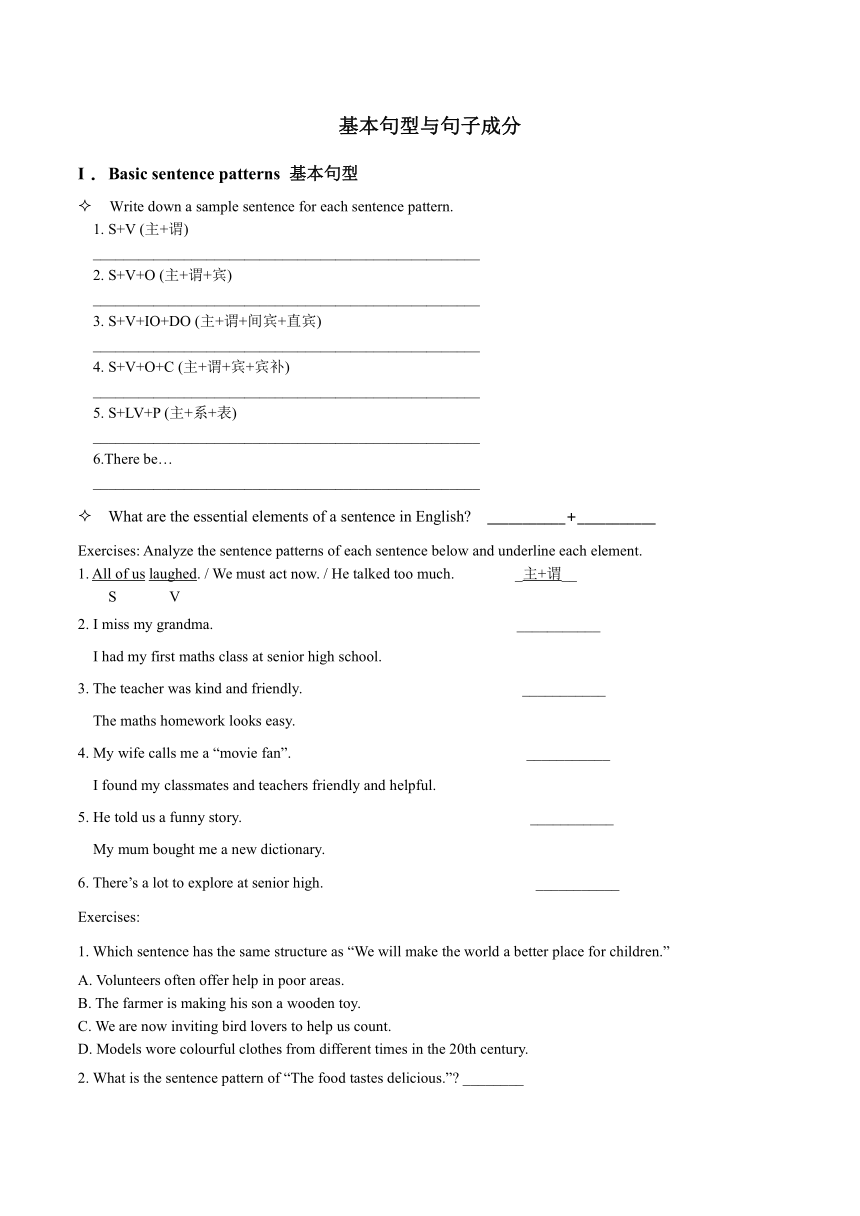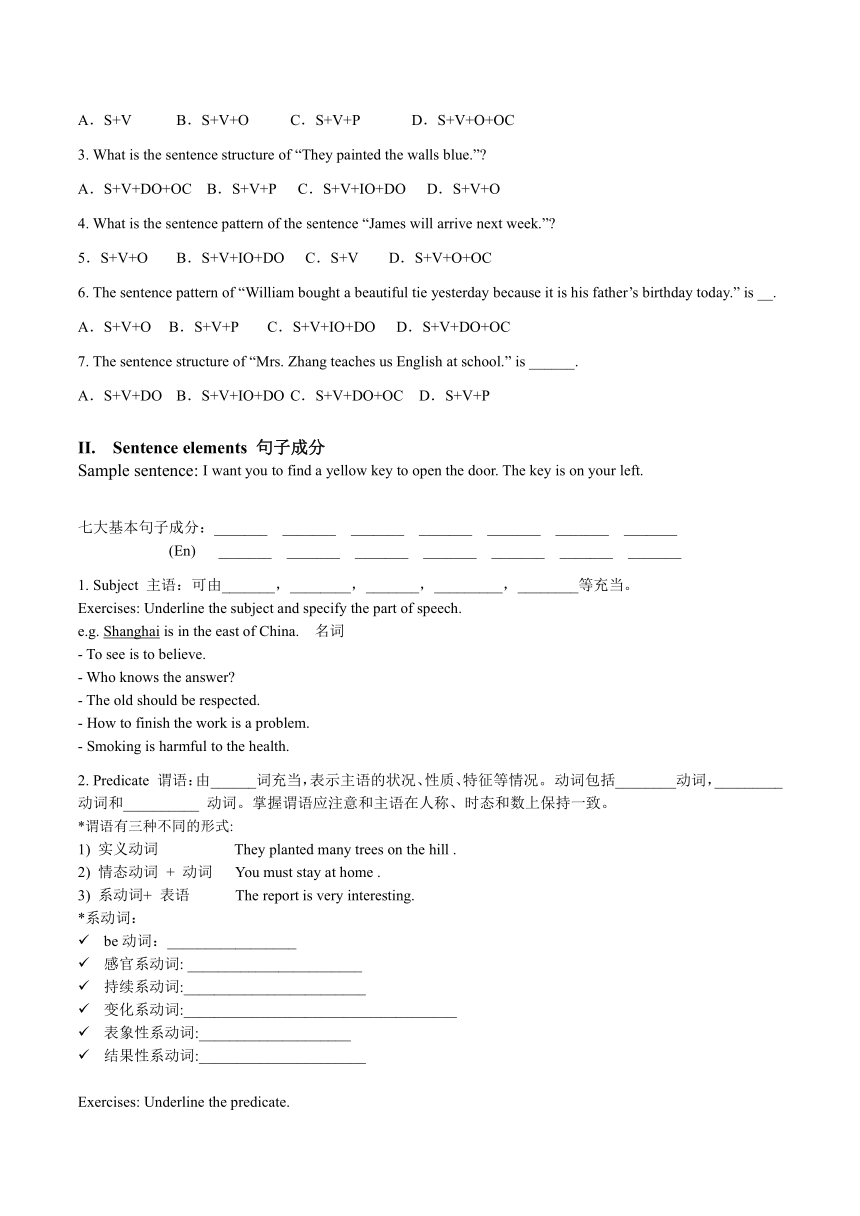语法练习 : sentence patterns and elements 2024年人教版英语九年级中考复习(无答案)
文档属性
| 名称 | 语法练习 : sentence patterns and elements 2024年人教版英语九年级中考复习(无答案) |  | |
| 格式 | docx | ||
| 文件大小 | 39.0KB | ||
| 资源类型 | 教案 | ||
| 版本资源 | 人教新目标(Go for it)版 | ||
| 科目 | 英语 | ||
| 更新时间 | 2024-05-01 11:58:44 | ||
图片预览


文档简介
基本句型与句子成分
Basic sentence patterns 基本句型
Write down a sample sentence for each sentence pattern.
1. S+V (主+谓)
___________________________________________________
2. S+V+O (主+谓+宾)
___________________________________________________
3. S+V+IO+DO (主+谓+间宾+直宾)
___________________________________________________
4. S+V+O+C (主+谓+宾+宾补)
___________________________________________________
5. S+LV+P (主+系+表)
___________________________________________________
6.There be…
___________________________________________________
What are the essential elements of a sentence in English ___________+___________
Exercises: Analyze the sentence patterns of each sentence below and underline each element.
1. All of us laughed. / We must act now. / He talked too much. _主+谓__
S V
2. I miss my grandma. ___________
I had my first maths class at senior high school.
3. The teacher was kind and friendly. ___________
The maths homework looks easy.
4. My wife calls me a “movie fan”. ___________
I found my classmates and teachers friendly and helpful.
5. He told us a funny story. ___________
My mum bought me a new dictionary.
6. There’s a lot to explore at senior high. ___________
Exercises:
1. Which sentence has the same structure as “We will make the world a better place for children.”
A. Volunteers often offer help in poor areas.
B. The farmer is making his son a wooden toy.
C. We are now inviting bird lovers to help us count.
D. Models wore colourful clothes from different times in the 20th century.
2. What is the sentence pattern of “The food tastes delicious.” ________
A.S+V B.S+V+O C.S+V+P D.S+V+O+OC
3. What is the sentence structure of “They painted the walls blue.”
A.S+V+DO+OC B.S+V+P C.S+V+IO+DO D.S+V+O
4. What is the sentence pattern of the sentence “James will arrive next week.”
5.S+V+O B.S+V+IO+DO C.S+V D.S+V+O+OC
6. The sentence pattern of “William bought a beautiful tie yesterday because it is his father’s birthday today.” is __.
A.S+V+O B.S+V+P C.S+V+IO+DO D.S+V+DO+OC
7. The sentence structure of “Mrs. Zhang teaches us English at school.” is ______.
A.S+V+DO B.S+V+IO+DO C.S+V+DO+OC D.S+V+P
II. Sentence elements 句子成分
Sample sentence: I want you to find a yellow key to open the door. The key is on your left.
七大基本句子成分:_______ _______ _______ _______ _______ _______ _______
(En) _______ _______ _______ _______ _______ _______ _______
1. Subject 主语:可由_______,________,_______,_________,________等充当。
Exercises: Underline the subject and specify the part of speech.
e.g. Shanghai is in the east of China. 名词
- To see is to believe.
- Who knows the answer
- The old should be respected.
- How to finish the work is a problem.
- Smoking is harmful to the health.
2. Predicate 谓语:由______词充当,表示主语的状况、性质、特征等情况。 动词包括________动词,_________动词和__________ 动词。掌握谓语应注意和主语在人称、时态和数上保持一致。
*谓语有三种不同的形式:
1) 实义动词 They planted many trees on the hill .
2) 情态动词 + 动词 You must stay at home .
3) 系动词+ 表语 The report is very interesting.
*系动词:
be动词:_________________
感官系动词: _______________________
持续系动词:________________________
变化系动词:____________________________________
表象性系动词:____________________
结果性系动词:______________________
Exercises: Underline the predicate.
1) We have finished reading this book.
2) My mother usually gets up early.
3) She seems tired.
4) We can all speak English.
5) The sun was shining.
3. Object宾语:在句子中主要充当动作的承受者,由________或相当于名词的词充当,一般位于及物动词(vt.)或介词(prep.)后。
E.g. 1) I like swimming. 2) The book includes many chapters.
Exercises: Translate the sentence and circle the object.
1) 谁知道这道题的答案? ________________________________________
2) 请不要拒绝帮他们。_______________________________________
3) 她喜欢弹钢琴。__________________________________________
4) 他承认犯了错误。________________________________________
5) 我不知道接下去该做什么。____________________________________
4. Predicate表语:由名词,形容词,副词,介词短语,不定式,动名词,短语,或者从句充当。表语位于_________后,构成系表结构。
Exercises: Underline the predicate.
① The old man was feeling tired.
② The leaves have turned yellow.
③ Soon they all became interested in the subject.
④ My dream is to become an astronomer.
5. Attribute定语:起修饰限制________或_________的作用,一般由形容词、数词、动词不定式、从句等。放在被修饰词前或后,可分为前置定语和后置定语。
1) The ________________ dictionary is useful. 英英字典很有用。
2) I don’t know ________ name. 我不知道他的名字
3) Mr. Pu is a ___________ teacher. 浦老师是一名幽默的老师。
4) I have _____________ homework___________. 我有许多作业要做。
5) We are the _________ students _____________. 我们是世界上最好的学生。
6. Adverbial状语:修饰_____________________或者_____________,表示行为发生的时间、地点、原因、目的、结果、程度等。
1) 他从上周起就在实验室一刻不停地做实验了。
He has done experiments _____________________________________
2) 我们十分专注地听想弄明白老师说的话。
We are listening attentively ___________________________________
3) 他正在吃面包因为他中午没时间吃午饭。
He is having bread _________________________________________
7. Complement 补语: 英语中有些及物动词后接宾语,意义仍不完整,还需要一个补足语,才能使整个句子的意义完整。由名词 、副词、形容词 、分词、不定式、介词短语和从句等充当。
Exercises: Underline the complement.
1) We had the car repaired.
2) I found the book interesting.
3) I asked her to go together with us.
4) I heard the child going upstairs.
* 8. Apposition 同位语:用来说明或解释同一事物,通常放在其所说明的名词或代词之后。名词、代词、数词等均可用作同位语。
e.g. 他(我的中文老师)很周到。He, __________________, is very considerate.
我们每个人都必须出现。 We________ must show up.
* 9. Independent element 独立成分
1) ______, I miss my grandma. (欧,表感叹)
2) I found my classmates and teachers friendly and helpful, _______________. (顺便说一句)
3) ______________, there’s a lot to explore at senior high. (相信我)
III. Parts of speech 词类/词性
单词根据其在句子中的功用,可以分成十个大类:
1 名词 _______(n.) e.g.___________ 2 代词 _________(pron.)e.g.___________
3 形容词 _________(adj.)e.g.__________ 4 副词 ________(adv.) e.g.___________
5 动词 ______(v.) e.g.____________ 6 数词 numeral (num.)e.g.___________
7 冠词 article (____)e.g.___________ 8 介词 preposition(_____)e.g.___________
9 连词 conjunction (______)e.g.___________ 10 感叹词 interjection (_____)e.g.__________
More exercises:
1. The leaves have turned yellow.
A. 谓语 B. 表语 C. 宾语 D. 定语
2. He told me not to make noise here.
A. 间接宾语 B. 直接宾语 C. 宾补 D. 表语
3. My grandma bought me a new schoolbag yesterday.
A. 主语 B. 直接宾语 C. 间接宾语 D. 宾语补足语
4. We must keep our classroom clean.
A. 主语 B. 谓语 C. 定语 D. 宾语补足语
5. The taxis in this city ________ in the same color. You can see them every day.
A. are B. has C. is D. have
Basic sentence patterns 基本句型
Write down a sample sentence for each sentence pattern.
1. S+V (主+谓)
___________________________________________________
2. S+V+O (主+谓+宾)
___________________________________________________
3. S+V+IO+DO (主+谓+间宾+直宾)
___________________________________________________
4. S+V+O+C (主+谓+宾+宾补)
___________________________________________________
5. S+LV+P (主+系+表)
___________________________________________________
6.There be…
___________________________________________________
What are the essential elements of a sentence in English ___________+___________
Exercises: Analyze the sentence patterns of each sentence below and underline each element.
1. All of us laughed. / We must act now. / He talked too much. _主+谓__
S V
2. I miss my grandma. ___________
I had my first maths class at senior high school.
3. The teacher was kind and friendly. ___________
The maths homework looks easy.
4. My wife calls me a “movie fan”. ___________
I found my classmates and teachers friendly and helpful.
5. He told us a funny story. ___________
My mum bought me a new dictionary.
6. There’s a lot to explore at senior high. ___________
Exercises:
1. Which sentence has the same structure as “We will make the world a better place for children.”
A. Volunteers often offer help in poor areas.
B. The farmer is making his son a wooden toy.
C. We are now inviting bird lovers to help us count.
D. Models wore colourful clothes from different times in the 20th century.
2. What is the sentence pattern of “The food tastes delicious.” ________
A.S+V B.S+V+O C.S+V+P D.S+V+O+OC
3. What is the sentence structure of “They painted the walls blue.”
A.S+V+DO+OC B.S+V+P C.S+V+IO+DO D.S+V+O
4. What is the sentence pattern of the sentence “James will arrive next week.”
5.S+V+O B.S+V+IO+DO C.S+V D.S+V+O+OC
6. The sentence pattern of “William bought a beautiful tie yesterday because it is his father’s birthday today.” is __.
A.S+V+O B.S+V+P C.S+V+IO+DO D.S+V+DO+OC
7. The sentence structure of “Mrs. Zhang teaches us English at school.” is ______.
A.S+V+DO B.S+V+IO+DO C.S+V+DO+OC D.S+V+P
II. Sentence elements 句子成分
Sample sentence: I want you to find a yellow key to open the door. The key is on your left.
七大基本句子成分:_______ _______ _______ _______ _______ _______ _______
(En) _______ _______ _______ _______ _______ _______ _______
1. Subject 主语:可由_______,________,_______,_________,________等充当。
Exercises: Underline the subject and specify the part of speech.
e.g. Shanghai is in the east of China. 名词
- To see is to believe.
- Who knows the answer
- The old should be respected.
- How to finish the work is a problem.
- Smoking is harmful to the health.
2. Predicate 谓语:由______词充当,表示主语的状况、性质、特征等情况。 动词包括________动词,_________动词和__________ 动词。掌握谓语应注意和主语在人称、时态和数上保持一致。
*谓语有三种不同的形式:
1) 实义动词 They planted many trees on the hill .
2) 情态动词 + 动词 You must stay at home .
3) 系动词+ 表语 The report is very interesting.
*系动词:
be动词:_________________
感官系动词: _______________________
持续系动词:________________________
变化系动词:____________________________________
表象性系动词:____________________
结果性系动词:______________________
Exercises: Underline the predicate.
1) We have finished reading this book.
2) My mother usually gets up early.
3) She seems tired.
4) We can all speak English.
5) The sun was shining.
3. Object宾语:在句子中主要充当动作的承受者,由________或相当于名词的词充当,一般位于及物动词(vt.)或介词(prep.)后。
E.g. 1) I like swimming. 2) The book includes many chapters.
Exercises: Translate the sentence and circle the object.
1) 谁知道这道题的答案? ________________________________________
2) 请不要拒绝帮他们。_______________________________________
3) 她喜欢弹钢琴。__________________________________________
4) 他承认犯了错误。________________________________________
5) 我不知道接下去该做什么。____________________________________
4. Predicate表语:由名词,形容词,副词,介词短语,不定式,动名词,短语,或者从句充当。表语位于_________后,构成系表结构。
Exercises: Underline the predicate.
① The old man was feeling tired.
② The leaves have turned yellow.
③ Soon they all became interested in the subject.
④ My dream is to become an astronomer.
5. Attribute定语:起修饰限制________或_________的作用,一般由形容词、数词、动词不定式、从句等。放在被修饰词前或后,可分为前置定语和后置定语。
1) The ________________ dictionary is useful. 英英字典很有用。
2) I don’t know ________ name. 我不知道他的名字
3) Mr. Pu is a ___________ teacher. 浦老师是一名幽默的老师。
4) I have _____________ homework___________. 我有许多作业要做。
5) We are the _________ students _____________. 我们是世界上最好的学生。
6. Adverbial状语:修饰_____________________或者_____________,表示行为发生的时间、地点、原因、目的、结果、程度等。
1) 他从上周起就在实验室一刻不停地做实验了。
He has done experiments _____________________________________
2) 我们十分专注地听想弄明白老师说的话。
We are listening attentively ___________________________________
3) 他正在吃面包因为他中午没时间吃午饭。
He is having bread _________________________________________
7. Complement 补语: 英语中有些及物动词后接宾语,意义仍不完整,还需要一个补足语,才能使整个句子的意义完整。由名词 、副词、形容词 、分词、不定式、介词短语和从句等充当。
Exercises: Underline the complement.
1) We had the car repaired.
2) I found the book interesting.
3) I asked her to go together with us.
4) I heard the child going upstairs.
* 8. Apposition 同位语:用来说明或解释同一事物,通常放在其所说明的名词或代词之后。名词、代词、数词等均可用作同位语。
e.g. 他(我的中文老师)很周到。He, __________________, is very considerate.
我们每个人都必须出现。 We________ must show up.
* 9. Independent element 独立成分
1) ______, I miss my grandma. (欧,表感叹)
2) I found my classmates and teachers friendly and helpful, _______________. (顺便说一句)
3) ______________, there’s a lot to explore at senior high. (相信我)
III. Parts of speech 词类/词性
单词根据其在句子中的功用,可以分成十个大类:
1 名词 _______(n.) e.g.___________ 2 代词 _________(pron.)e.g.___________
3 形容词 _________(adj.)e.g.__________ 4 副词 ________(adv.) e.g.___________
5 动词 ______(v.) e.g.____________ 6 数词 numeral (num.)e.g.___________
7 冠词 article (____)e.g.___________ 8 介词 preposition(_____)e.g.___________
9 连词 conjunction (______)e.g.___________ 10 感叹词 interjection (_____)e.g.__________
More exercises:
1. The leaves have turned yellow.
A. 谓语 B. 表语 C. 宾语 D. 定语
2. He told me not to make noise here.
A. 间接宾语 B. 直接宾语 C. 宾补 D. 表语
3. My grandma bought me a new schoolbag yesterday.
A. 主语 B. 直接宾语 C. 间接宾语 D. 宾语补足语
4. We must keep our classroom clean.
A. 主语 B. 谓语 C. 定语 D. 宾语补足语
5. The taxis in this city ________ in the same color. You can see them every day.
A. are B. has C. is D. have
同课章节目录
